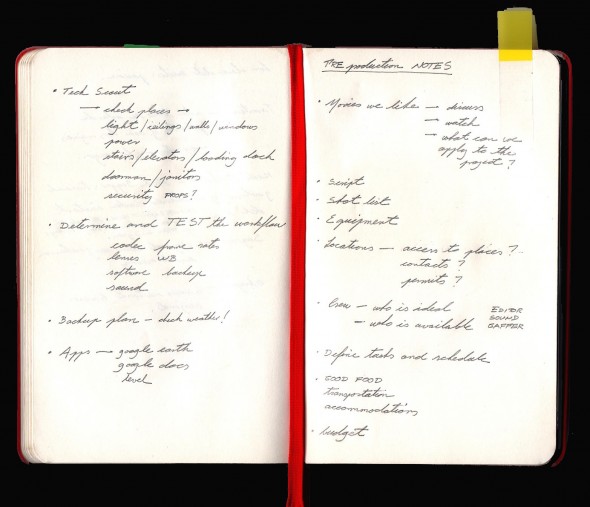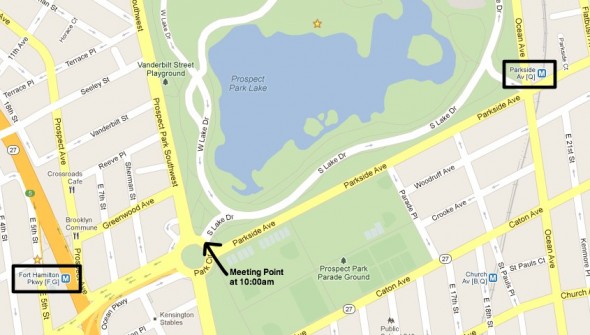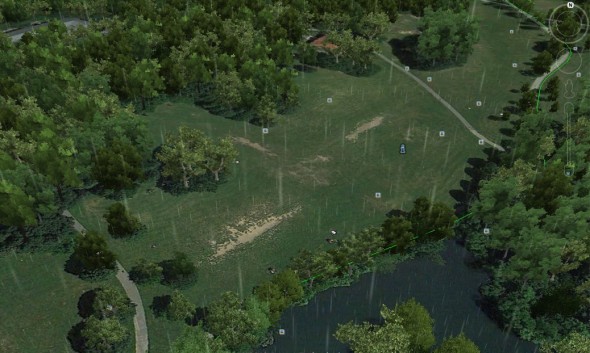Video
Notes from the Field.
This is a scan from my journal that I bring with me to every preproduction meeting that I have with clients, directors, producers, and others. In this scan you can see my handy “preproduction notes.”
Here’s how my system works: first, I like to get the conversation going by sharing movies that we like and movies that could be related to the project at hand. This helps tremendously in our effort to understand both technically and aesthetically what the client or director is going after, and if we are a good match for the project.
About a year ago I sat down with a director who began envisioning a project as “film noir meets science fiction/kung fu—but in a funny way,” which saved us both a lot of time, as I was definitively not interested!
Let’s take a look at the other things I consider on every video production:
• Script: Do we have a script? Is it from a book or is it an original script? When can I see it? If there isn’t a script, who is going to write it and when? This is a very important step. Even though I always write the scripts for my own projects, it needs to be clearly defined who will perform this integral part when it comes to someone else’s project. I have been using Celtx, and I am very happy with the results. The script is by far THE most important piece on any video production puzzle.
• Shot list: As soon as I have the script, I start creating a shot list: what kind of gear do we need? Do we own it? Do we need to rent it? How many shots can we accomplish in one day? The answers to these questions can vary greatly depending on location, the scenes’ complexity, permits, and even the weather.
• Location Permits: Since most of us don’t have access to Hollywood’s sets and production budgets, being creative is extremely important. Having access to locations that other people don’t have access to is key. There are several beautiful abandoned buildings on Wall Street that no one knows about. In Harlem there are fantastic mansions that you can shoot if you know the right people. Battery Park is Federal property while Central Park is not. Both require shooting permits, issued by different offices.
• Location Scouting: I am often surprised to see how many people ignore this critical step. In cities like New York things change, and they change fast. The park that you so fondly remember is now a parking lot. And that awesome abandoned building? Well, it’s now a luxury condo.
With current smart phone applications you don’t need to bring a lot of gear. How tall are the ceilings? What is the color of the walls? Where are the windows? Do you have easy access to power outlets? Freight elevators? Loading docks? It pays to plan ahead.
• Crew: The two main questions are: who would be ideal for this job, and, who is available? The answers very often don’t match up. Once you have your “dream team” set up it is important to clearly define tasks. You might have three photographers working together and all of them want to be the director of photography at the same time. This cannot happen. At a minimum you will need a director, a producer, a director of photography, a gaffer, and someone in charge of sound. You will also need an experienced video editor. If you are only two people, it does not mean that these jobs go away or are not needed. It means that each one of you will be doing several jobs at once, which is not ideal.
• Food: I absolutely believe that feeding your crew well is paramount. It is the least you can do for people giving you their time and knowledge and making your dreams possible. Unless you are in high school and this is your first shoot, pizza and pop don’t cut it anymore.
• Budget: This is perhaps the most important and difficult part to master. Additional gear, unreliable crewmembers, unpredictable weather, or re-shoots can throw a perfectly calculated budget out the window. It is very easy to underestimate the time needed for postproduction. Leave ample room for emergencies. The money runs out faster at the end.
• Security: Who has access to the freight elevator? Are there limited access hours? Some buildings in Manhattan will only use the freight elevator on certain weekdays. Who will be the manager on duty?
• Workflow: I cannot emphasize this enough: test your workflow before your start shooting. Test your file formats, your memory cards, your hard drives and editing software, and never, ever, bring gear that you don’t know how to use to a shoot.
• Back-Up Plan: You can control many things, but you cannot control the weather. You always need a Plan B. If you show up and no one is there, what would you do? If the chosen location is not available, where do you go next? If you have 10 people with you, how will you be moving around? HDSLR systems overheat easily, especially during the summer and shooting outside. Be sure to bring a back up system. Bring back up batteries, bulbs, cards. This is common sense. But common sense is not common.
• Applications:
We use Google Documents to share information with the rest of the crew in one single document containing the day’s itinerary, schedule, contact information, locations, weather forecasts, last minute details, etc. Starting time changed? Are we switching locations? No problem. With Google Docs everyone has access to the most current version of any document.
We also love Google Earth: Remember the time when you had to fly somewhere or hire a local scout to research certain locations? Google Earth is a godsend. You can access any location and determine accurate sunrise and sunset times, interesting vantage points, and even nearby accommodations.
• Gear: The gear list is so long and changes so often that it deserves a separate post. In the meantime check PDN’s recent article “13 Products You Need to Add HD Video to Your Business.” The article is available as a complementary download to our newsletter subscribers. Click here to sign up!
We hope this helps you to streamline your preproduction workflow. These are all things that we have learned from experience and that have been extremely helpful on every new assignment that we accept. If you want to share your experiences or add something we might have missed please add your comments below.



